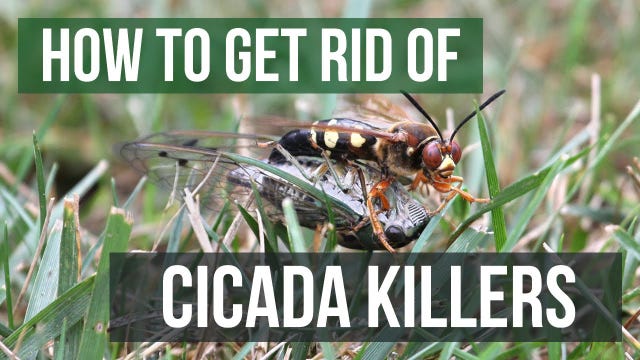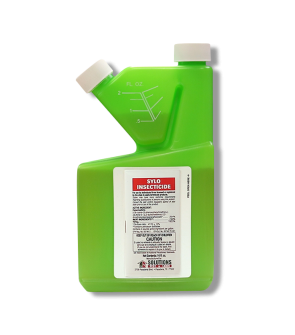Gain access to personalized product screening, the best pricing, rewards, and more!
Most Effective Products
Cicada Killer Control: How to Get Rid of Cicada Killer Wasps
Cicada Killers, also known as ground digger wasps, are a common wasp species encountered by homeowners, especially those living in the warmer parts of the country. They can be alarming at first glance because they look like oversized bees flying around in yards or gardens. Due to their size, cicada killers are often mistaken for the European Hornet and, most recently in the U.S., the Asian Giant Hornet.
Cicada killer wasps are named after their tendency to hunt down and kill Cicadas and Locusts, paralyzing them with their stingers and carrying their bodies down to their underground holes to feast upon.
Though not as aggressive as wasps and hornets, Cicada killers will sting as a last resort out of self-defense if disturbed. Combined with their large, scary size, ability to sting, and habit of digging unsightly holes in yards to nest, this pest can be pretty troublesome.
Our DIY cicada killer wasp treatment guide will show you how to eliminate a cicada killer wasp infestation quickly. Follow the steps below carefully and use the recommended products to the side, and you will be guaranteed to drive cicada killers out of your yard.
Identification

Encountering a cicada killer wasp can be frightening, but for good reason, they are huge! Coupled with their menacing appearance, it's easy for any home or property owner to be concerned. But if you're not sure you are seeing a cicada killer, here are some things you can look for to help you identify.
- Cicada killer wasps can grow to as big as 1.5 to 2 inches in length.
- Cicada lillers have a black body and a bright yellow stripe around the abdomen.
- They have large brownish-orange wings and large bulging red eyes.
- Cicada killers are also known as "ground digger wasps" because of their tendency to live in holes they make in the ground, where they live and nest.
- Cicada killers feed on plant nectar and not other insects or organic matter.
- Cicada killers are solitary ground-digger wasps that nest alone in underground burrows.
Use the description and image above to help you identify cicada killer wasps on your property. If you are having trouble, reach out to us, and one of our pest control experts will help you properly ID the pest and offer product recommendations for control.
Inspection

After properly identifying cicada killers on your property, you can proceed with the inspection. During this step, you determine where cicada killers are found in your yard and the conditions attracting them to your home.
Where To Inspect
Cicada killers like to live in backyards, flower beds, and grassy areas, which is why homeowners frequently encounter them.
However, the presence of cicada killers may not indicate that a nest is in the area. Cicada killers burrow their nests in the ground, especially in sandy soils.
What To Look For
Look for cicada killer wasps themselves or cicada killer wasp nests. It may be helpful to observe their flight tendencies.
If you find one, follow it closely, and they may lead you to where their nest is if it is set up in your yard.
Cicada killer nests are tunnels that are dug in the ground. They will appear as a dirt hill with a 1 to 1.5-inch diameter hole in the middle that they use as their entrance. Once you have identified their nests, you'll be ready for treatment.
Treatment
If you are up to the job, it’s best to wear protective clothing and gear to keep you safe from potential harm.
To get rid of cicada killer wasps, figure out where they are nesting and treat the hole directly with Sylo Insecticide.
Remember first to read all product labels, follow the application instructions on these labels, and stay safe by wearing personal protective equipment.
Step 1: Direct Nest Treatment With Sylo Insecticide

Sylo Insecticide is a synthetic pyrethroid insecticide containing the active ingredient cyclomethrin. It is a good contact insecticide that effectively kills cicada killers. This chemical is a residual insecticide and should be used if you have located the nest so you can spray directly inside the tunnels. The chemical traces allow the larvae to be killed as well.
You will use a 0.25% emulsion (1.3 fl. oz. per gallon) of Sylo Insecticide in a sprayer with a gallon of water to spot-treat the nests you have located, making sure to apply to all of them in one visit.
Locating the nest and treating it directly is vital to successfully controlling the cicada killers, as the product will not work as a spot treatment if you can't find the nest.
To treat cicada killer Wasp burrows, place your sprayer on a pinstream setting and spray at low pressure.
Spray a small solution area around the burrow's entrance and apply the Sylo Insecticide directly into the nest. Cicada burrows can run up to 5 feet long and 15 inches deep underground, so spray the hole thoroughly.
You should apply the insecticide preferably in the evening, as this is when it is most likely that all the adult Cicada Killer Wasps are inside. Proceed with caution and wear protective long-sleeve clothing, as there is a chance Cicada Killers may come out and try to sting you.
Prevention

After successfully removing cicada killer wasps from your yard, you want to ensure they don't make a return. Chances are, cicada killers may have laid eggs before succumbing to insecticides, and soon, the eggs will hatch, bringing on a new generation of cicada killers and creating problems. Also, cicada killer Wasp pheromones may be left behind, which may draw other cicada killers to your property.
Some cultural practices you can implement to reduce cicada killer wasp populations and discourage them from your property are to:
- Properly maintain your lawn to promote thick, dense turf. Maintain regular mowing.
- Water your lawn deeply with 1 to 1.5 inches of water.
- Put at least 3 inches of mulch under shrubbery and in your garden or flowerbeds.
- You can also try mowing the lawn on a higher setting of 3 to 4 inches, as tall vegetation is unappealing to cicada killers and will make them less likely to dig a nesting tunnel in your yard.
- If visible tunnels pop up, apply Sylo Insecticide directly to these tunnels as soon as they are spotted.
Key Takeaways
What are Cicada Killer Wasps?
- Cicada killers are a large wasp species that are harmless to humans but can be annoying to have flying around your home and garden.
- They get their name because of their tendency to target and kill cicadas for a meal.
How To Get Rid of Cicada Killers
- Our top recommendation for treating Cicada Killers is to locate their nest and apply Sylo Insecticide. Locating and treating the nest directly is crucial as spot treatments or spraying in general areas where cicada killers have been active is ineffective.
Preventing Cicada Killer Reinfestation
- To prevent cicada killer wasps, keep your lawn turfgrass long during the active periods when Cicada Killers arrive in the summer to discourage them from digging tunnels. Water your lawn frequently and mow at 3 to 4 inches to promote well-nourished turf and strong roots that make it difficult for cicada killers to burrow through. Any tunnels that are formed should be immediately treated with Sylo Insecticide.








